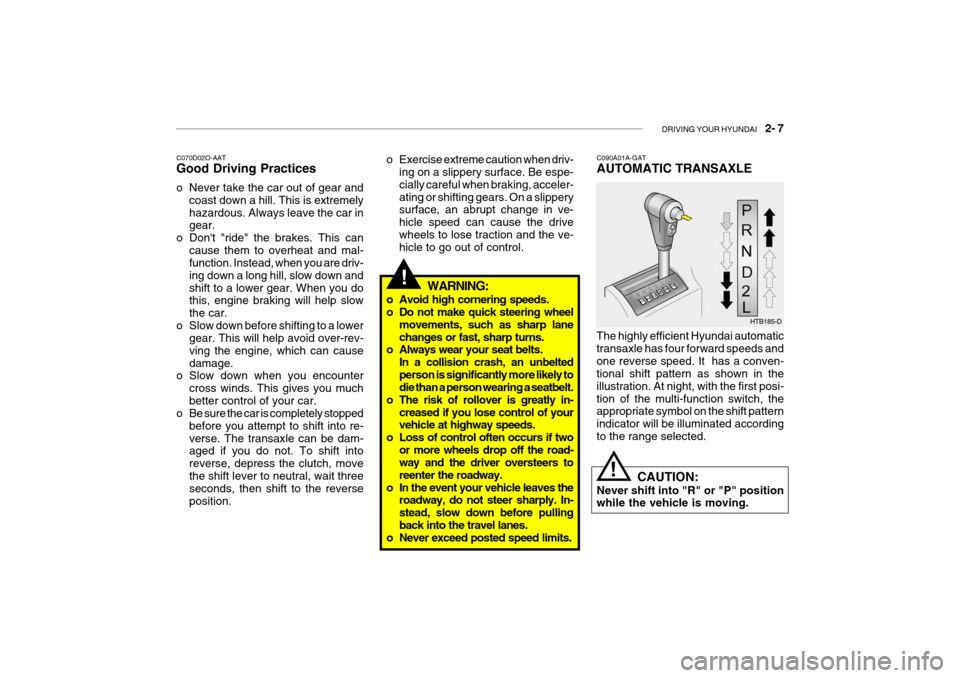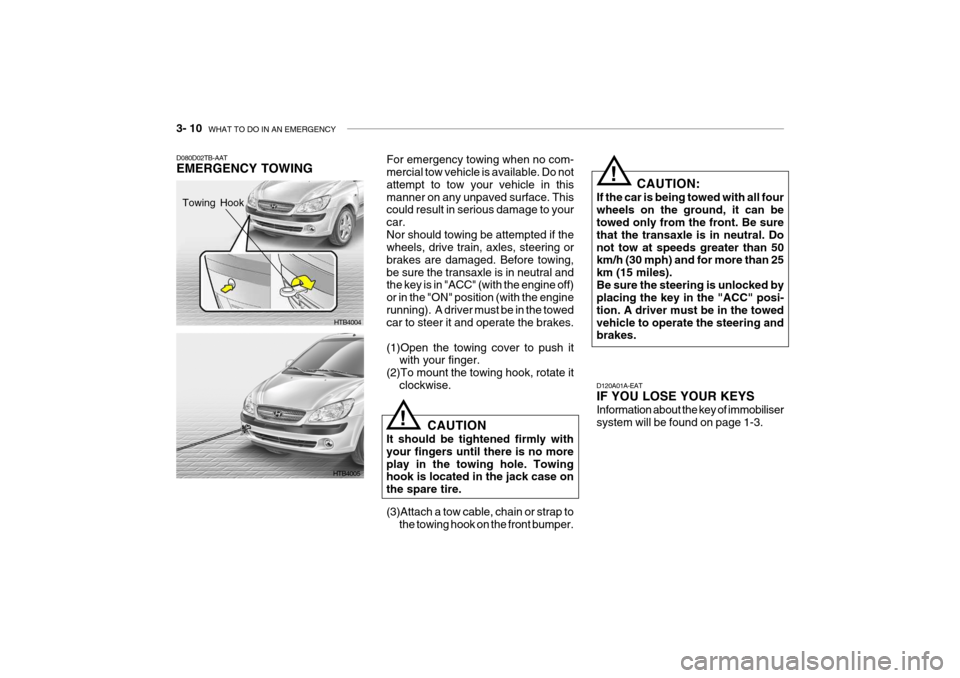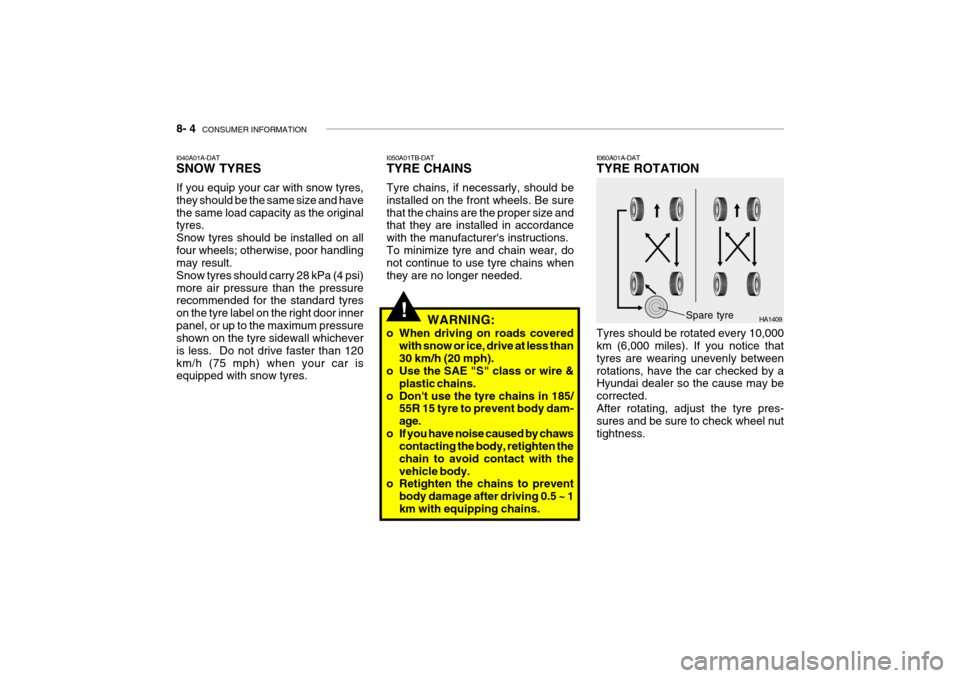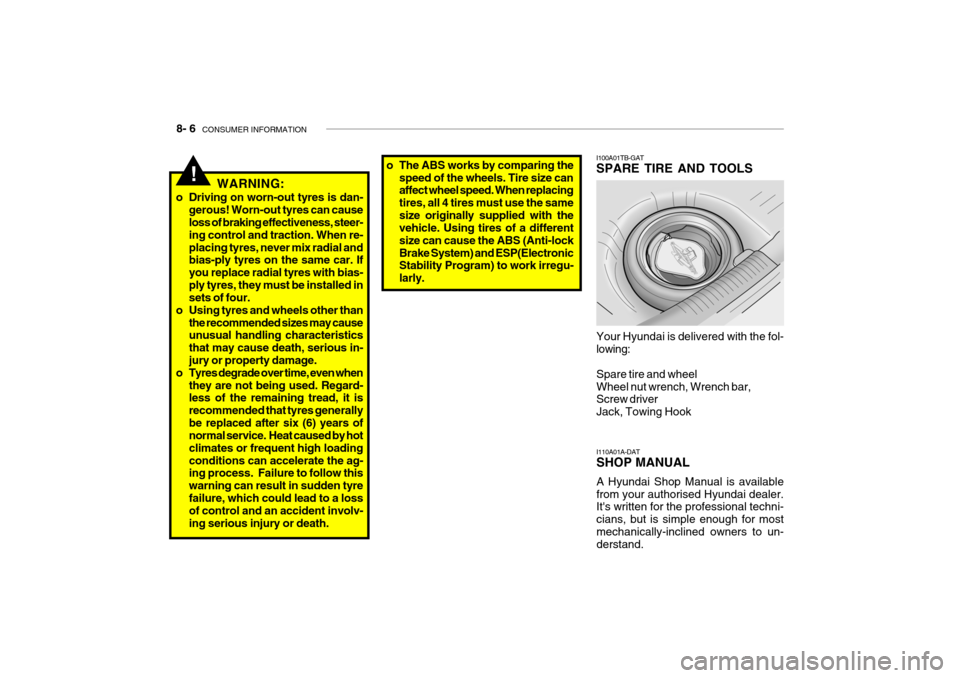four wheel drive Hyundai Getz 2009 Owner's Manual - RHD (UK, Australia)
[x] Cancel search | Manufacturer: HYUNDAI, Model Year: 2009, Model line: Getz, Model: Hyundai Getz 2009Pages: 191, PDF Size: 6.3 MB
Page 102 of 191

DRIVING YOUR HYUNDAI 2- 7
!
o Exercise extreme caution when driv-
ing on a slippery surface. Be espe- cially careful when braking, acceler-ating or shifting gears. On a slippery surface, an abrupt change in ve- hicle speed can cause the drivewheels to lose traction and the ve- hicle to go out of control.
C070D02O-AAT Good Driving Practices
o Never take the car out of gear and
coast down a hill. This is extremely hazardous. Always leave the car in gear.
o Don't "ride" the brakes. This can
cause them to overheat and mal-function. Instead, when you are driv- ing down a long hill, slow down andshift to a lower gear. When you do this, engine braking will help slow the car.
o Slow down before shifting to a lower gear. This will help avoid over-rev-ving the engine, which can causedamage.
o Slow down when you encounter
cross winds. This gives you muchbetter control of your car.
o Be sure the car is completely stopped
before you attempt to shift into re-verse. The transaxle can be dam- aged if you do not. To shift into reverse, depress the clutch, movethe shift lever to neutral, wait three seconds, then shift to the reverse position. HTB185-D
C090A01A-GAT AUTOMATIC TRANSAXLE
The highly efficient Hyundai automatic transaxle has four forward speeds andone reverse speed. It has a conven- tional shift pattern as shown in the illustration. At night, with the first posi-tion of the multi-function switch, the appropriate symbol on the shift pattern indicator will be illuminated accordingto the range selected. CAUTION:
Never shift into "R" or "P" position while the vehicle is moving.
!
WARNING:
o Avoid high cornering speeds.
o Do not make quick steering wheel movements, such as sharp lane changes or fast, sharp turns.
o Always wear your seat belts.
In a collision crash, an unbeltedperson is significantly more likely to die than a person wearing a seatbelt.
o The risk of rollover is greatly in-
creased if you lose control of yourvehicle at highway speeds.
o Loss of control often occurs if two
or more wheels drop off the road-way and the driver oversteers to reenter the roadway.
o In the event your vehicle leaves the roadway, do not steer sharply. In-stead, slow down before pullingback into the travel lanes.
o Never exceed posted speed limits.
Page 126 of 191

3- 10 WHAT TO DO IN AN EMERGENCY
D080D02TB-AAT EMERGENCY TOWING For emergency towing when no com- mercial tow vehicle is available. Do not attempt to tow your vehicle in thismanner on any unpaved surface. This could result in serious damage to your car.Nor should towing be attempted if the wheels, drive train, axles, steering or brakes are damaged. Before towing,be sure the transaxle is in neutral and the key is in "ACC" (with the engine off) or in the "ON" position (with the enginerunning). A driver must be in the towed car to steer it and operate the brakes. (1)Open the towing cover to push it
with your finger.
(2)To mount the towing hook, rotate it clockwise.
HTB4004
D120A01A-EAT IF YOU LOSE YOUR KEYS Information about the key of immobiliser system will be found on page 1-3.
HTB4005 CAUTION:
If the car is being towed with all fourwheels on the ground, it can be towed only from the front. Be sure that the transaxle is in neutral. Donot tow at speeds greater than 50 km/h (30 mph) and for more than 25 km (15 miles).Be sure the steering is unlocked by placing the key in the "ACC" posi- tion. A driver must be in the towedvehicle to operate the steering and brakes.
!
CAUTION
It should be tightened firmly with your fingers until there is no moreplay in the towing hole. Towing hook is located in the jack case on the spare tire. (3)Attach a tow cable, chain or strap to the towing hook on the front bumper.
!
Towing Hook
Page 180 of 191

8- 4 CONSUMER INFORMATION
!
I050A01TB-DAT TYRE CHAINS Tyre chains, if necessarly, should be installed on the front wheels. Be surethat the chains are the proper size and that they are installed in accordance with the manufacturer's instructions.To minimize tyre and chain wear, do not continue to use tyre chains when they are no longer needed.
I040A01A-DAT SNOW TYRES If you equip your car with snow tyres, they should be the same size and havethe same load capacity as the original tyres. Snow tyres should be installed on allfour wheels; otherwise, poor handling may result. Snow tyres should carry 28 kPa (4 psi)more air pressure than the pressure recommended for the standard tyres on the tyre label on the right door innerpanel, or up to the maximum pressure shown on the tyre sidewall whichever is less. Do not drive faster than 120km/h (75 mph) when your car is equipped with snow tyres. I060A01A-DAT TYRE ROTATION Tyres should be rotated every 10,000 km (6,000 miles). If you notice that tyres are wearing unevenly betweenrotations, have the car checked by a Hyundai dealer so the cause may be corrected.After rotating, adjust the tyre pres- sures and be sure to check wheel nut tightness.
HA1409Spare tyre
WARNING:
o When driving on roads covered with snow or ice, drive at less than 30 km/h (20 mph).
o Use the SAE "S" class or wire &
plastic chains.
o Don't use the tyre chains in 185/ 55R 15 tyre to prevent body dam-age.
o If you have noise caused by chaws contacting the body, retighten thechain to avoid contact with thevehicle body.
o Retighten the chains to prevent
body damage after driving 0.5 ~ 1km with equipping chains.
Page 182 of 191

8- 6 CONSUMER INFORMATION
I100A01TB-GAT SPARE TIRE AND TOOLS
Your Hyundai is delivered with the fol- lowing: Spare tire and wheel Wheel nut wrench, Wrench bar, Screw driver Jack, Towing Hook HTB224
I110A01A-DAT SHOP MANUAL A Hyundai Shop Manual is available from your authorised Hyundai dealer. It's written for the professional techni- cians, but is simple enough for mostmechanically-inclined owners to un- derstand.
!WARNING:
o Driving on worn-out tyres is dan- gerous! Worn-out tyres can cause loss of braking effectiveness, steer- ing control and traction. When re-placing tyres, never mix radial and bias-ply tyres on the same car. If you replace radial tyres with bias-ply tyres, they must be installed in sets of four.
o Using tyres and wheels other than
the recommended sizes may causeunusual handling characteristics that may cause death, serious in- jury or property damage.
o Tyres degrade over time, even when
they are not being used. Regard-less of the remaining tread, it is recommended that tyres generallybe replaced after six (6) years of normal service. Heat caused by hot climates or frequent high loadingconditions can accelerate the ag- ing process. Failure to follow this warning can result in sudden tyrefailure, which could lead to a loss of control and an accident involv- ing serious injury or death. o The ABS works by comparing the
speed of the wheels. Tire size can affect wheel speed. When replacing tires, all 4 tires must use the samesize originally supplied with the vehicle. Using tires of a different size can cause the ABS (Anti-lockBrake System) and ESP(Electronic Stability Program) to work irregu- larly.